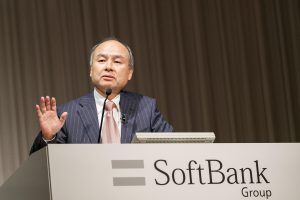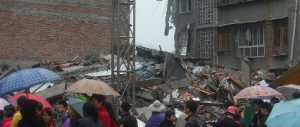I’ve returned from a sobering United Nations-led tour of six tsunami-damaged communities and two radiation-impacted cities in northern Japan. The obvious conclusion: the Fukushima Daiichi nuclear accident is forcing Japan to go green.
Steps include the launch of a new renewable energy national feed-in tariff, which starts in July. Meanwhile, the governor of Fukushima, Yuhei Sato, told us that renewables will be the “key factor” in the revival of his devastated prefecture.
Though little planning for integrating this economic and energy transformation is in evidence yet, we did witness fragmented signs that Japan can provide a developed-nation role model for resilience in the face of cultural, energy system and environmental devastation.
Organised by the Nagoya, Japan-based UN Center for Regional Development (UNCRD), we travelled for a week as part of a fact-finding mission with UNCRD director Chikako Takase and her staff. The mission was called “Reconstruction Towards Sustainable Communities” and my role was to advise Japanese community leaders on green economic development recovery strategies and opportunities. I had met with a range of clean tech energy companies and urban planning and design firms in preparation, as well as the US Department of Commerce.
I was joined by experts from five countries: Japan, Australia, Bangladesh, Thailand and the United States. One fellow American represented the Federal Emergency Management Agency (FEMA). It seems our contingent was somewhat of a novelty. I was told by the UN and the US Embassy in Tokyo that we were one of the first (if not the first) from outside the three affected prefectures to meet with local leaders on reconstruction and post-disaster management planning.
The tsunami-scoured coastal cities where some 20,000 died – even now, bodies are being discovered by white ships trolling the coast and on land by locals – are focused on the future of survivors. We visited temporary housing and retail developments, modular constructed units complete with such personal flourishes as lanterns, public benches and landscaping. They house locally owned businesses, from bars to barbers to fishmongers, which were wiped out by the tsunami.
Three hundred thousand people in this region were driven from their homes by the “tsunami attack”. Communities have submitted reconstruction plans to the national government and these proposals are in the process of being approved for funding. But actual rebuilding will not begin for years. The ground is still unstable or sinking in the coastal cities due to the 9.0 subduction earthquake (meaning one tectonic plate went under another, causing one plate to sink).
Meanwhile, waste-management issues, including removal of radiation and salt-contaminated soil and debris from the tsunami, bedevil everyone from small farmers to civil authorities. In one city, 106 years worth of waste was piled around what used to be the town centre. The rest of Japan is disinclined to accept much of it, because of potential radioactivity.
When and if they are able to build, the plans of two tsunami-ravaged cities stand out for being smart growth models. Ishinomaki was a pre-tsunami city of about 160,000: 4000 were killed by the tsunami, the most deaths of any city in Japan. Its entire port and low-lying downtown areas were virtually annihilated, with the odd building and remnant inexplicably standing, such as a domed cartoon art museum and, most bizarrely, a Statue of Liberty replica formerly housed in a pachinko parlour.
Ishinomaki has a plan to virtually wipe clean its remaining “ghost” downtown to create a mixed-use residential and commercial zone that will be two to three times denser than before, according to city leaders we met. The city hopes to be better protected from the coast through site elevation, barriers and other features. The more vexing question is how to keep its young people from leaving the area for Tokyo and other big cities to the south: transit-oriented redesign will be one factor making younger citizens less likely to flee.
Another critical planning issue is how male-dominated Japan intends to ensure that all its citizens, including women, the elderly and handicapped in disaster-struck communities are part of the process of designing their future.
Rikuzentakata, a city of 22,000 (2,000 died in the tsunami), has plans to make “new energy” a key part of its redevelopment. This city which was reported to have been “wiped off the map” by 19.2 metre-high waves, is today pursuing national government subsidies and private investments to create large-scale distributed generation of renewables, including solar PV, land and marine biomass and offshore wind.
Together with other nearby communities, Rikuzentakata is studying how to trade domestic carbon credits for reduced emissions. The city’s quest for zero waste and zero carbon-dioxide emissions also has it exploring industrial ecology strategies: using fish bones, tsunami debris wastes or other byproducts such as waste heat as inputs for new processes.
We also toured a small community-supported organic farm in southern Fukushima Prefecture, outside the town of Iwaki. A volunteer group had recruited helpers the previous summer to remove radiated soil, and the farmers showed us how recent radiation tests had come up negative. Meanwhile, the “hot” soil they had dug out and scraped away was still heaped in a pile, because the national government would not remove or receive it, as the farmers had been led to believe they would.
Lunch found us back in Iwaki, eating at a small take-out place in someone’s home. Although every item served was organic and local, including mushrooms, for once in my life this type of fare made me lose my appetite.
Prior to the Fukushima disaster, Japan relied on nuclear energy for 25% to 33% of its needs. This summer, the last two remaining nuclear plants operating in Japan (out of 54) will be shut down, at least temporarily, and there are many signs throughout the nation that electric power is already in short supply. Although outdoor temperatures were hovering between zero and four degrees Celsius, we attended multiple meetings circled around one or two kerosene heaters, in buildings using almost no electric light, without the use of central indoor heating. Is this a glimpse into what a business-as-usual energy future looks like in other industrial countries?
One meeting in a luxury high-rise hotel in Minami Sanriku had a planned blackout for two hours while we met with business and community volunteer leaders, along with the hotel’s owner, who had sheltered and fed 400 community members after the tsunami (the bottom two stories were damaged, but the rest of the building was habitable). Staff handed out heavy winter parkas so we could continue our discussions in relative warmth.
Besides jackets, Japan has been using technology to cope with its new dilemma. Utility sponsored websites and mobile apps let people know exactly when to conserve the most, which they have been doing by hanging wet clothes to dry in south-facing windows or balconies, and by curtailing use of light, heat or appliances. So far, Japanese society has reduced its energy use to meet a 30% power deficit, but the margin between rolling or planned blackouts and power is paper thin, even in Tokyo.
Our delegation will now work with UNCRD to develop recommendations based on our visit to Tohoku’s three stricken prefectures. My prediction is that Iwate, Miyagi and Fukushima will remain in the global consciousness long into the future, not just for their triple disaster, but also for the lessons they underscore for all of us as we venture into an uncertain future for energy, water, food, and shelter in the wake of disasters, natural or not.
Warren Karlenzig is president of Common Current. He is a fellow at the Post-Carbon Institute and co-author of the United Nations Shanghai Manual on global sustainable city planning and management.
This article is published here as part of Nuclear Enery and Developement Programme, which is supported by the Heinrich-Boell Foundation.
Homepage Image by CoCreatr


